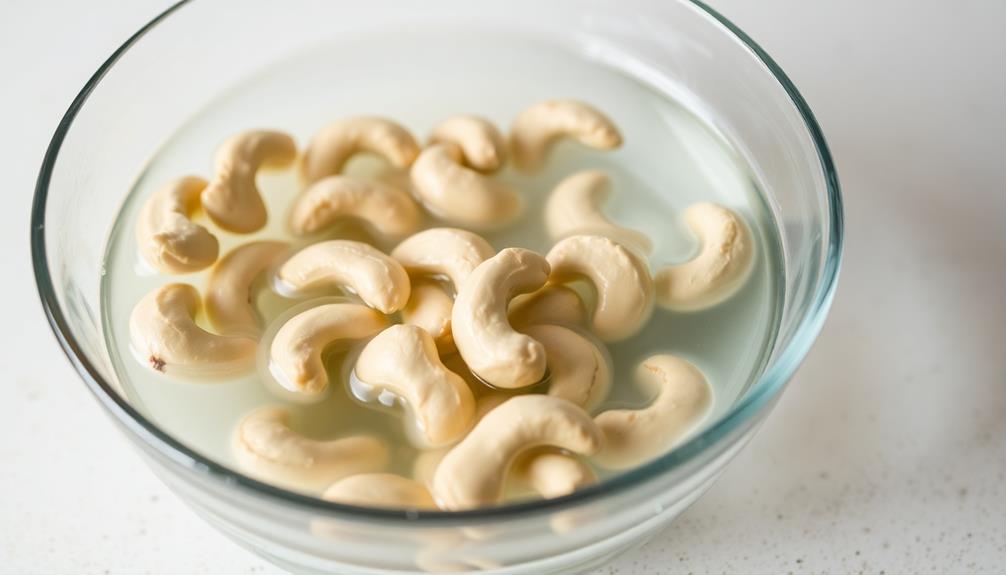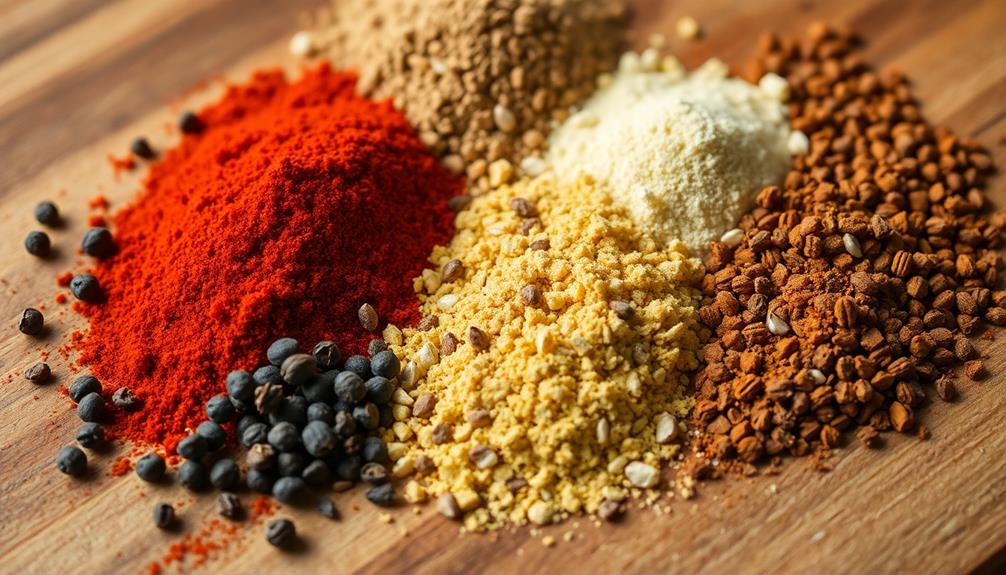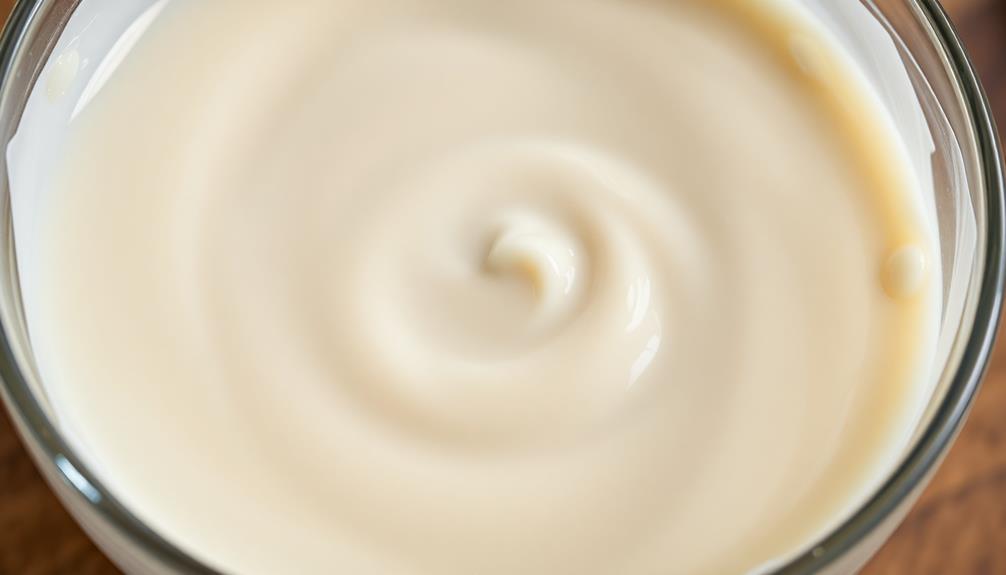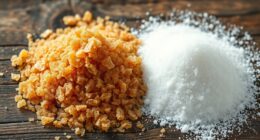Cashew cream has become a versatile dairy replacement, allowing you to enjoy creamy textures and flavors without animal products. Packed with healthy fats, protein, and essential vitamins, it's easy to make at home by soaking cashews, blending them with water, and seasoning to taste. You can use cashew cream as a substitute for heavy cream, sour cream, or cream cheese in all kinds of dishes – from savory sauces and dips to decadent desserts. Its neutral flavor makes it a canvas for endless culinary creativity. Keep reading to discover even more ways to incorporate this nutritious and versatile ingredient into your cooking.
Key Takeaways
- Cashew cream is a dairy-free alternative that can be used in various recipes, from savory sauces to creamy desserts, providing a rich, indulgent texture.
- Nutritionally, cashew cream is high in healthy fats, protein, and essential vitamins and minerals, making it a nutritious addition to one's diet.
- The preparation of cashew cream is simple, requiring just a few ingredients and minimal hands-on time, allowing for easy incorporation into home-cooked meals.
- Cashew cream's versatility enables customization of flavors and consistency, enabling users to adapt it to their specific culinary needs and dietary preferences.
- Incorporating cashew cream into one's cooking encourages culinary creativity and exploration, as it serves as a versatile base for various cuisines and dishes.
History
Cashew's journey into the culinary world can be traced back centuries. Originating in Brazil, the cashew tree and its unique, kidney-shaped nut have long been a part of indigenous diets.
However, it wasn't until the 16th century that cashews began to spread across the globe, thanks to Portuguese explorers who carried them to Asia and Africa.
Over time, the versatile cashew nut has found its way into countless recipes and cuisines. Its creamy texture and mild flavor make it an excellent dairy replacement, particularly in the form of cashew cream.
This versatile ingredient can be used to create rich, decadent sauces, dips, and even desserts, providing a plant-based alternative to traditional dairy products. As awareness of dietary restrictions and plant-based eating has grown, cashew cream has become an increasingly popular choice for health-conscious cooks and those looking to explore new culinary possibilities.
Recipe
Cashew cream is a versatile dairy-free alternative that can be used in a wide range of recipes, from creamy soups and sauces to decadent desserts. This simple, nut-based cream is a fantastic option for those looking to add a rich, velvety texture to their dishes without the use of dairy products.
The process of making cashew cream is straightforward and can be easily incorporated into your cooking routine. The key is to start with high-quality raw cashews and soak them in water to soften them, which allows for a smooth and creamy texture when blended.
Ingredients:
- 1 cup raw cashews
- 1 cup water
- 1/4 teaspoon salt (optional)
Instructions:
Soak the cashews in water for at least 4 hours, or up to 8 hours if you have the time. Drain and rinse the soaked cashews, then add them to a high-speed blender along with the 1 cup of fresh water and the salt (if using). Blend on high speed until the mixture is completely smooth and creamy, about 2-3 minutes.
Once the cashew cream is ready, it can be used in a variety of recipes. The texture can be adjusted by adding more or less water to achieve the desired consistency.
Cashew cream can be stored in an airtight container in the refrigerator for up to 5 days, making it a convenient ingredient to have on hand for quick and easy meal preparation.
Cooking Steps
First, you'll need to soak the cashews in water overnight.
Drain and rinse the soaked cashews, then blend them until they're smooth.
Step 1. Soak Cashews in Water Overnight

Begin by soaking the cashews in water overnight. This simple step is crucial for preparing creamy, smooth cashew cream. Place the raw, unsalted cashews in a bowl and cover them with clean water. Let them soak for at least 8 hours or up to 12 hours. The longer soak time will result in even creamier cashew cream.
After the soaking period, drain and rinse the cashews well. This removes any impurities or bitterness from the nuts. You can then proceed to blend the cashews into a rich, velvety cream.
The soaked cashews will break down easily, creating a thick, luxurious texture perfect for using in sauces, dips, desserts, and more. Soaking is an essential first step that unlocks the full potential of cashews for a variety of delicious dairy-free recipes.
With just a bit of advance planning, you'll have perfectly softened cashews ready to transform into creamy goodness.
Step 2. Drain and Rinse Soaked Cashews

After the cashews have soaked overnight, drain and rinse them thoroughly under running water. This step is crucial to remove any residual water from the soaking process.
Simply place a mesh strainer in the sink and pour the cashews into it, letting the water drain away. Then, run cool water over the cashews, gently stirring them with your hands to ensure they're fully rinsed. This helps remove any impurities or flavors that may have been absorbed during the soak.
Once the water runs clear, you're ready to proceed with the next step in making your creamy cashew-based recipe. Properly draining and rinsing the soaked cashews sets you up for success, allowing the cashew cream to have a smooth, silky texture without any gritty or off-flavors.
With this simple prep work done, you can now move on to blending the cashews into a luscious, dairy-free cream.
Step 3. Blend Soaked Cashews Until Smooth

With the cashews properly drained and rinsed, you'll now want to blend them into a smooth, creamy cashew cream.
Add the cashews to a high-powered blender or food processor. Pulse at first to break them down, then blend on high speed for 2-3 minutes, stopping to scrape down the sides as needed.
The key is to blend until the cashews are completely smooth and creamy, with no gritty or crunchy bits remaining.
The texture you're aiming for is similar to heavy cream or a rich, velvety puree. Adjust the speed and blend time as necessary to achieve this consistency.
If the mixture seems too thick, you can thin it out by adding a bit of water, plant-based milk, or broth, a tablespoon at a time, until it reaches your desired creaminess.
Once blended, your versatile cashew cream is ready to use in a variety of sweet and savory recipes.
Step 4. Season With Desired Spices

Now that you've blended the cashews into a smooth, creamy consistency, you can start seasoning the cashew cream to suit your culinary needs.
The possibilities are endless when it comes to flavoring your cashew cream. You might want to add a pinch of garlic powder, onion powder, or even some dried herbs like thyme, rosemary, or basil.
If you're in the mood for something a little spicier, try adding a dash of cayenne pepper or chili powder. Don't be afraid to get creative and experiment with different spice combinations.
You can also stir in a bit of lemon juice or apple cider vinegar to brighten up the flavor. Once you've added your desired seasonings, give the cashew cream a good stir to incorporate everything evenly.
Taste it and adjust the seasoning as needed until it's just right. With a few simple tweaks, you can transform the basic cashew cream into a versatile, flavorful ingredient for all sorts of dishes.
Step 5. Use as Desired

You can use the cashew cream in a variety of ways. It makes a great dairy-free alternative for recipes that call for heavy cream, sour cream, or even cream cheese. Simply swap it in cup-for-cup to create creamy soups, dips, and desserts. The mild flavor blends seamlessly, allowing the other ingredients to shine.
Try folding it into mashed potatoes for an extra-rich and silky texture. Stir it into pasta sauces for a luxurious creaminess. Use it to make creamy salad dressings and veggie dips. The possibilities are endless! For a tangy twist, mix in a bit of lemon juice or apple cider vinegar.
You can also use cashew cream as a topping. Dollop it onto baked potatoes, tacos, or chili. Drizzle it over roasted vegetables or grain bowls. Or whip it with a touch of sweetener to make a creamy fruit dip or topping for pies and cakes.
Experiment and have fun bringing this versatile dairy-free ingredient into your cooking.
Final Thoughts
Undoubtedly, cashew cream is a versatile and nutritious ingredient that can elevate a wide range of dishes. Whether you're whipping up a creamy pasta sauce, baking decadent desserts, or crafting a luscious dip, this dairy-free alternative offers a world of culinary possibilities.
Its smooth, rich texture can mimic the mouthfeel of traditional cream, making it an excellent choice for those seeking a plant-based option. Additionally, consider pairing it with eco-friendly materials that enhance your cooking experience while being mindful of health and sustainability. For those looking to reduce their consumption of dairy products, the avocado cream substitute can provide a creamy and delicious alternative. Its versatility allows for it to be used in a variety of recipes, from dressings and dips to sauces and desserts. By incorporating this plant-based option into your cooking routine, you can enjoy the benefits of a healthier and more sustainable lifestyle.
Beyond its culinary applications, cashew cream is also a nutritious choice. Packed with healthy fats, protein, and a variety of essential vitamins and minerals, it's a great way to boost the nutritional value of your meals. Plus, it's easy to make at home, allowing you to control the ingredients and customize the flavor to suit your tastes.
As you continue to experiment with cashew cream, don't be afraid to get creative. Explore new recipes, blend it with fresh herbs and spices, or use it as a base for your favorite dishes. The possibilities are endless, and the rewards are truly delicious.
Frequently Asked Questions
How Long Does Homemade Cashew Cream Last in the Refrigerator?
Homemade cashew cream can last up to 5 days in the refrigerator when stored properly in an airtight container. It's important to consume it within this timeframe for optimal freshness and flavor.
Can Cashew Cream Be Frozen for Long-Term Storage?
Yes, you can freeze cashew cream for long-term storage. It'll keep for up to 3 months in the freezer. Just be sure to thaw it in the refrigerator before using it in your recipes.
Is Cashew Cream Suitable for Those With Nut Allergies?
No, cashew cream is not suitable for those with nut allergies. Cashews are tree nuts, and consuming them can trigger severe allergic reactions in individuals with nut allergies. It's essential to avoid cashew cream if you have a nut allergy.
How Does the Taste and Texture of Cashew Cream Compare to Dairy Cream?
The taste of cashew cream is richer and creamier compared to dairy cream, with a smooth, velvety texture. It has a slightly nutty flavor that can complement sweet and savory dishes.
Can Cashew Cream Be Used as a Substitute for Heavy Cream in Baking?
Yes, you can substitute cashew cream for heavy cream in baking. The creamy texture and neutral flavor of cashew cream make it a great dairy-free replacement, allowing you to create delicious baked goods without the dairy.









